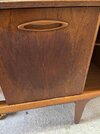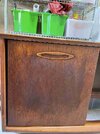I agree that it's a probably a 1960s/70s piece, but if it is solid teak the finish would have been oil (it is very difficult to spray finish oily timbers with any form of lacquer consistently). Conny, which century are you in? Nobody has used French polish commercially (for factory made furniture) since before WWII, nice though it is. I'm with you on the sanding back, though
OP, you always need to strip an entire door or panel when refinishing furniture unless you are expert at blending in. I suspect the original finish is blocking absorption of the new finish. Be careful if this is a veneered piece (you should be able to make out the lippings at the edges of doors and drawer fronts) - veneers are very thin and it doesn't take much sanding to go through them



